A Human Body Skin-structure Quiz!
(118).jpg)
How well do you understand the human body's skin structure? Take this skin structure quiz to test your knowledge. Here, you will find the questions about the human body's underlying and most elementary structure, skin. It's easy to take your skin for granted, but when you consider how it protects your body from harm, it is something we should appreciate more. Do you know as much as you should about it? You can share this skin diagram quiz with others, also.
- 1.
What does this detailed image show?
- A.
Hair
- B.
Skin Structure
- C.
Plant cells
- D.
Human bones
Correct Answer
B. Skin StructureExplanation
The detailed image shows the structure of the skin. This can be inferred from the options given, where the other options such as hair, plant cells, and human bones do not align with the subject matter of the image.Rate this question:
-
- 2.
Label A is:
- A.
Hair Root
- B.
Hair Follicle Receptor
- C.
Hair Shaft
- D.
Hair Follicle
Correct Answer
C. Hair ShaftExplanation
The correct answer is "Hair Shaft" because it is the visible part of the hair that protrudes from the skin's surface. The hair shaft is composed of dead cells that have been pushed up through the hair follicle. It is responsible for protecting the scalp and providing insulation. The other options, such as hair root, hair follicle receptor, and hair follicle, are all related to the structure and growth of the hair, but they are not the visible part of the hair that is referred to as the hair shaft.Rate this question:
-
- 3.
Label B is:
- A.
Meissner's Corpuscles
- B.
Pacinian Corpuscle
- C.
Pore
- D.
Free Nerve Ending
Correct Answer
C. PoreExplanation
Label B is a pore. A pore is a small opening in the skin that allows substances such as sweat or oil to pass through. It does not contain any specialized sensory receptors like Meissner's corpuscles or Pacinian corpuscles, which are responsible for detecting touch and pressure. It also does not have the characteristics of a free nerve ending, which are nerve endings that are not associated with any specialized structure and are responsible for detecting pain and temperature.Rate this question:
-
- 4.
Label C is:
- A.
Dermal Papillae Layer
- B.
Arrector Pili Muscle
- C.
Sebaceous (oil) Gland
- D.
Artery
Correct Answer
A. Dermal Papillae LayerExplanation
The correct answer is the Dermal Papillae Layer. Dermal papillae are small, finger-like projections in the upper layer of the skin called the dermis. They play a crucial role in the formation of fingerprints and provide nutrients to the epidermis. The dermal papillae layer also contains blood vessels, nerve endings, and sensory receptors, making it an essential component of the skin's structure and function.Rate this question:
-
- 5.
Label D is:
- A.
Sebaceous (oil) gland
- B.
Arrector Pili Muscle
- C.
Adipose Tissue
- D.
Meissner's Corpuscle
Correct Answer
D. Meissner's CorpuscleExplanation
Meissner's corpuscles are sensory receptors located in the skin that are responsible for detecting light touch and vibration. They are found in the dermal papillae, which are small projections in the upper layer of the skin. These corpuscles have a unique structure that allows them to sense and transmit tactile information to the brain. They are particularly abundant in areas of the body that are more sensitive to touch, such as the fingertips and lips.Rate this question:
-
- 6.
Label E is:
- A.
Sensory Nerve Fiber
- B.
Hair Follicle Receptor
- C.
Free Nerve Ending
- D.
Reticular Layer of the dermis
Correct Answer
C. Free Nerve EndingExplanation
Label E is a free nerve ending. Free nerve endings are sensory receptors that are found throughout the body and are responsible for detecting pain, temperature, and touch sensations. They are the most common type of sensory receptor and can be found in the skin, mucous membranes, and internal organs. Free nerve endings have unmyelinated nerve fibers that are sensitive to various stimuli, allowing them to transmit sensory information to the brain.Rate this question:
-
- 7.
Label F is:
- A.
Reticular Layer of Dermis
- B.
Dermal Papillae Layer
- C.
Sensory Nerve Fiber
- D.
Artery
Correct Answer
A. Reticular Layer of DermisExplanation
Label F is the reticular layer of the dermis. The reticular layer is the deeper layer of the dermis, located below the papillary layer. It is composed of dense irregular connective tissue that provides strength and support to the skin. This layer contains collagen and elastin fibers, blood vessels, sweat glands, hair follicles, and sebaceous glands. The reticular layer is responsible for the elasticity and resilience of the skin, as well as housing various structures essential for the skin's function.Rate this question:
-
- 8.
Label G is:
- A.
Sebaceous (oil) Gland
- B.
Eccrine Sweat Gland
- C.
Eccrine Sweat Gland
- D.
Adipose Tissue
Correct Answer
A. Sebaceous (oil) GlandExplanation
Label G is the sebaceous (oil) gland. This gland is responsible for producing and secreting sebum, an oily substance that helps to lubricate and waterproof the skin. The sebaceous glands are typically connected to hair follicles and are most commonly found on the face, scalp, and upper back. They play a crucial role in maintaining the health and hydration of the skin.Rate this question:
-
- 9.
Label H is:
- A.
Pacinian Corpuscle
- B.
Arrector Pili Muscle
- C.
Hair Follicle Receptor
- D.
Pore
Correct Answer
B. Arrector Pili MuscleExplanation
The correct answer is Arrector Pili Muscle. The arrector pili muscle is a small muscle attached to the base of a hair follicle. When this muscle contracts, it causes the hair to stand up, resulting in what is commonly known as "goosebumps." This muscle is responsible for the involuntary response to cold or fear, where the hair on our body stands on end. The other options, Pacinian Corpuscle, Hair Follicle Receptor, and Pore, do not refer to muscles and are not related to the phenomenon of goosebumps.Rate this question:
-
- 10.
Label I is:
- A.
Sensory Nerve Fiber
- B.
Hair Follicle Receptor
- C.
Free Nerve Ending
- D.
Reticular Layer of Dermis
Correct Answer
A. Sensory Nerve FiberExplanation
The correct answer is Sensory Nerve Fiber because sensory nerve fibers are responsible for transmitting sensory information from the peripheral nervous system to the central nervous system. They are specialized to detect various stimuli such as touch, temperature, and pain. In the context of the given options, a sensory nerve fiber is the most appropriate label for I as it is involved in sensory perception.Rate this question:
-
- 11.
Label J is:
- A.
Adipose Tissue
- B.
Hypodermis
- C.
Sebaceous (oil) Gland
- D.
Eccrine Sweat Glands
Correct Answer
D. Eccrine Sweat GlandsExplanation
Label J is eccrine sweat glands because it is the only option that matches the given label. Adipose tissue, hypodermis, and sebaceous glands are all different structures that are not represented by label J. Therefore, the correct answer is eccrine sweat glands.Rate this question:
-
- 12.
Label K is:
- A.
Meissner's Corpuscle
- B.
Eccrine Sweat Gland
- C.
Pacinian Corpuscle
- D.
Arrector Pili Muscle
Correct Answer
C. Pacinian CorpuscleExplanation
The Pacinian corpuscle is a specialized sensory receptor found in the skin that detects deep pressure and vibration. It is composed of layers of connective tissue surrounding a nerve ending. When pressure or vibration is applied to the skin, the layers of the corpuscle deform and stimulate the nerve ending, sending signals to the brain. This allows us to perceive sensations such as the touch of an object or the vibration of a sound.Rate this question:
-
- 13.
Label L is:
- A.
Reticular Layer of Dermis
- B.
Hair Follicle Receptor
- C.
Vein
- D.
Artery
Correct Answer
D. ArteryExplanation
Label L is an artery. Arteries are blood vessels that carry oxygenated blood away from the heart to various parts of the body. They have thick, elastic walls that help them withstand the high pressure of blood flow. In the context of the given options, the other choices such as the reticular layer of dermis, hair follicle receptor, and vein do not accurately describe an artery.Rate this question:
-
- 14.
Label M is:
- A.
Dermal Papillae Layer
- B.
Vein
- C.
Hair Root
- D.
Artery
Correct Answer
B. VeinExplanation
Label M is a vein because veins are blood vessels that carry deoxygenated blood back to the heart. They have thin walls and are often located closer to the surface of the skin compared to arteries. In the given options, the other choices such as dermal papillae layer, hair root, and artery do not match the characteristics of a vein. Therefore, the correct answer is vein.Rate this question:
-
- 15.
Label N is:
- A.
Adipose Tissue
- B.
Eccrine Sweat Gland
- C.
Pacinian Corpuscle
- D.
Dermis
Correct Answer
A. Adipose TissueExplanation
Adipose tissue is the correct answer because it is a type of connective tissue that stores fat cells. It is found throughout the body and serves as a cushioning and insulating layer. Adipose tissue is responsible for storing energy in the form of fat and also plays a role in regulating body temperature. It is characterized by its large, round cells that are filled with lipid droplets.Rate this question:
-
- 16.
Layer O is:
- A.
Hair Follicle Receptor
- B.
Sensory Nerve Fiber
- C.
Free Nerve Ending
- D.
Hair Shaft
Correct Answer
A. Hair Follicle ReceptorExplanation
The hair follicle receptor is a sensory receptor located in the hair follicle. It is responsible for detecting changes in the position of the hair shaft and transmitting this information to the sensory nerve fibers. This allows us to sense movements or vibrations on the surface of the skin, such as when a bug lands on our arm or when we brush our hair. The hair follicle receptor plays an important role in our sense of touch and helps us to perceive and respond to our environment.Rate this question:
-
- 17.
Label P is:
- A.
Arrector Pili Muscle
- B.
Meissner's Corpuscle
- C.
Eccrine Sweat Gland
- D.
Adipose Tissue
Correct Answer
C. Eccrine Sweat GlandExplanation
The given correct answer is "Eccrine Sweat Gland." The eccrine sweat gland is a type of sweat gland found in the skin. It is responsible for producing sweat, which helps regulate body temperature. Sweat produced by eccrine sweat glands is mostly composed of water and electrolytes. These glands are distributed all over the body and are particularly abundant on the palms of the hands, soles of the feet, and forehead. They play a crucial role in thermoregulation and are activated during physical activity or in response to heat.Rate this question:
-
- 18.
Label Q is:
- A.
Hair Root
- B.
Pore
- C.
Hair Shaft
- D.
Hair Follicle
Correct Answer
D. Hair FollicleExplanation
The hair follicle is the correct answer because it is the structure that surrounds and protects the hair root. It is responsible for producing and nourishing the hair shaft, which is the visible part of the hair. The hair follicle also contains the sebaceous gland, which produces oil to keep the hair and scalp moisturized.Rate this question:
-
- 19.
Label R is:
- A.
Eccrine Sweat Gland
- B.
Hair Root
- C.
Hair Shaft
- D.
Hair Follicle
Correct Answer
B. Hair RootExplanation
Label R is the hair root because it is the part of the hair that is located beneath the surface of the skin. The hair root is responsible for anchoring the hair follicle and providing nourishment to the hair shaft. It also contains the hair bulb, which is the living part of the hair and is responsible for hair growth. Therefore, based on this information, it can be concluded that the correct answer is hair root.Rate this question:
-
- 20.
Label S is:
- A.
Hypodermis (superficial fascia)
- B.
Hair Shaft
- C.
Epidermis
- D.
Dermal Papillae Layer
Correct Answer
A. Hypodermis (superficial fascia)Explanation
The label S is the hypodermis (superficial fascia). The hypodermis is the layer of tissue that lies beneath the dermis and serves as a connection between the skin and underlying structures such as muscles and bones. It is composed of adipose tissue, which helps to insulate the body and provide cushioning. The hypodermis also contains blood vessels and nerves that supply the skin.Rate this question:
-
- 21.
Label T is:
- A.
Epidermis
- B.
Vein
- C.
Dermal Papillae Layer
- D.
Dermis
Correct Answer
D. DermisExplanation
The correct answer is "Dermis" because the label T refers to the layer of skin that lies beneath the epidermis. The dermis is composed of connective tissue and contains blood vessels, nerves, hair follicles, and sweat glands. It provides support and nourishment to the epidermis and is responsible for the strength and elasticity of the skin.Rate this question:
-
- 22.
Label U is:
- A.
Hypodermis
- B.
Epidermis
- C.
Dermal Pappilae Layer
- D.
Dermis
Correct Answer
B. EpidermisExplanation
The correct answer is Epidermis. The epidermis is the outermost layer of the skin and acts as a protective barrier between the body and the external environment. It is made up of multiple layers of cells and does not contain blood vessels. The epidermis is responsible for producing melanin, the pigment that gives color to the skin, and also plays a role in regulating body temperature and preventing water loss.Rate this question:
-
Quiz Review Timeline +
Our quizzes are rigorously reviewed, monitored and continuously updated by our expert board to maintain accuracy, relevance, and timeliness.
-
Current Version
-
Sep 13, 2023Quiz Edited by
ProProfs Editorial Team -
Mar 02, 2011Quiz Created by
Brittany Allen
 Back to top
Back to top










-Gland-.webp)
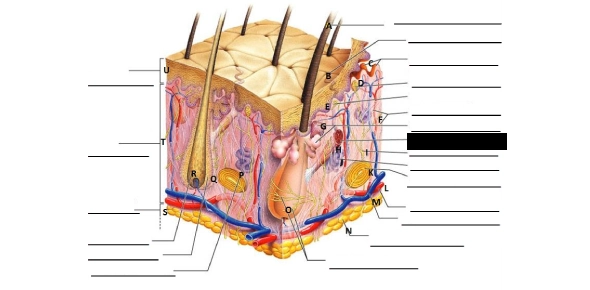
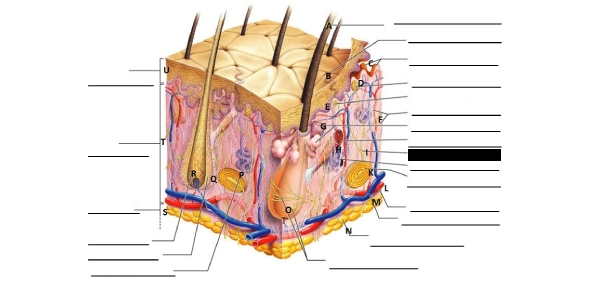
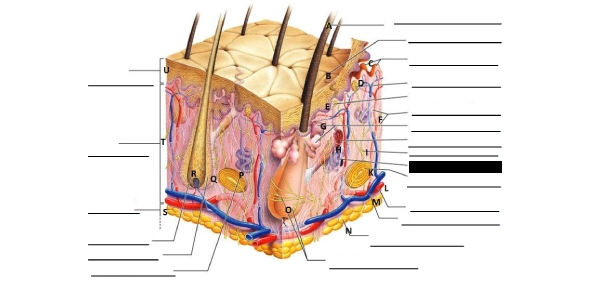
.webp)
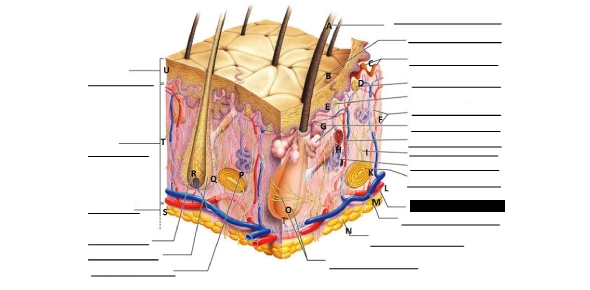

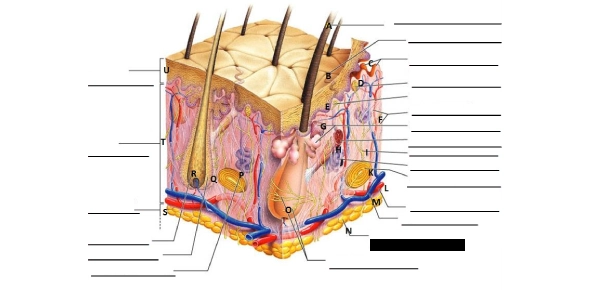


.webp)
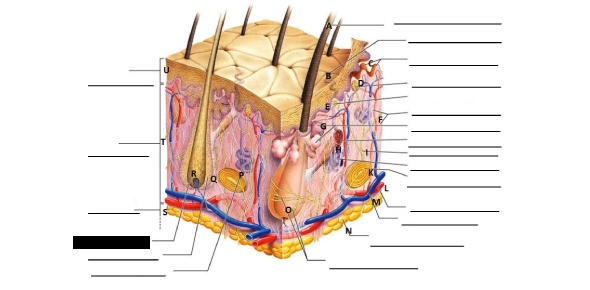
-.webp)
.webp)
.webp)